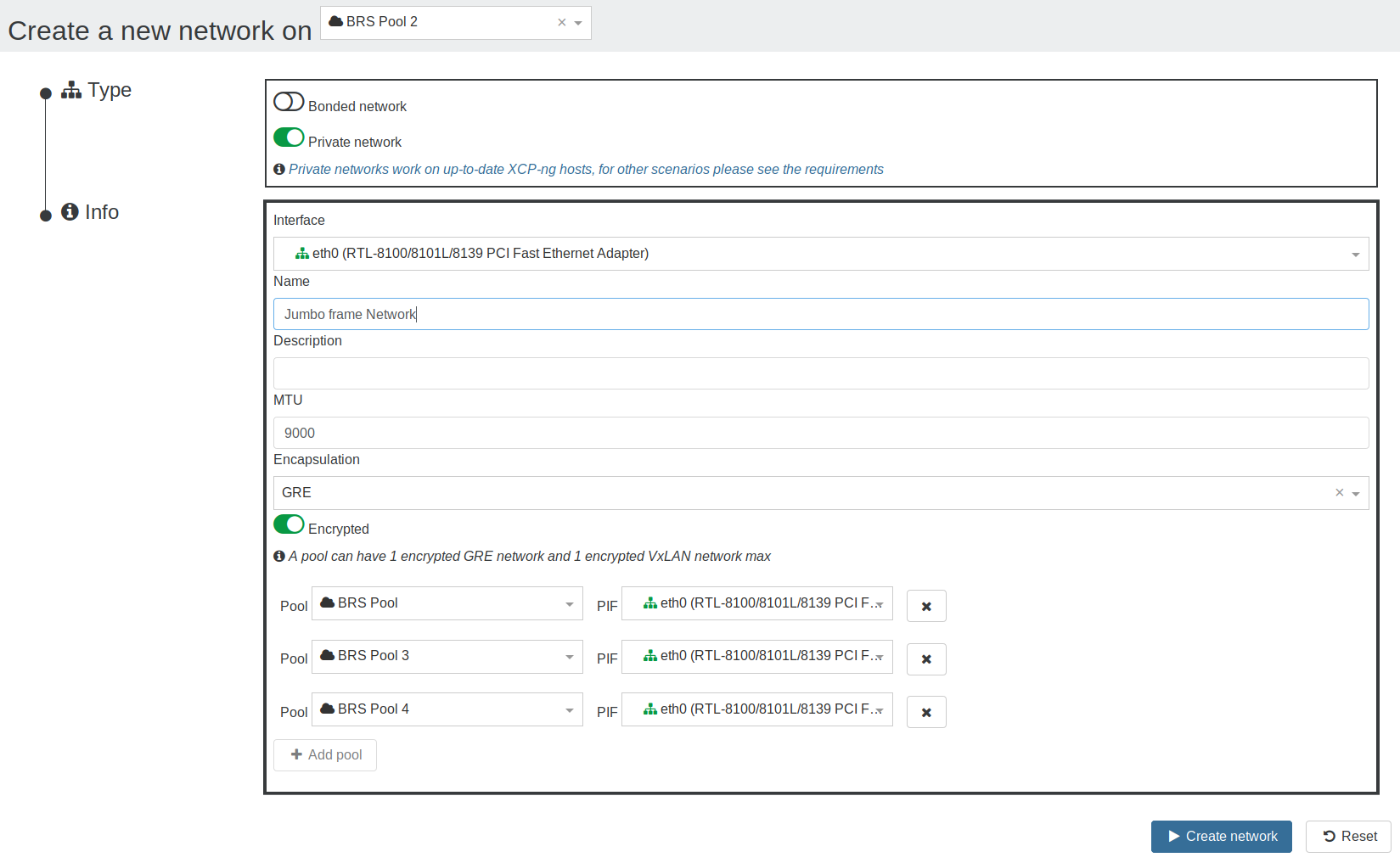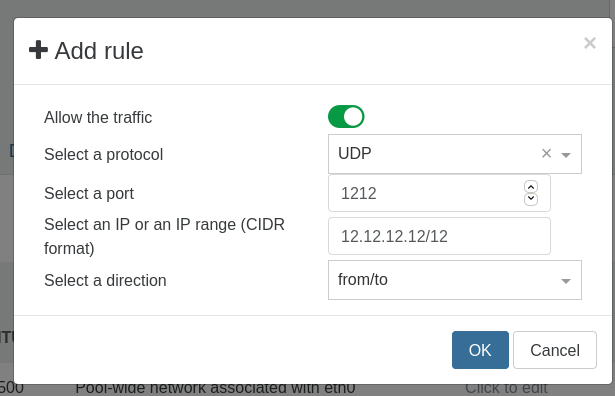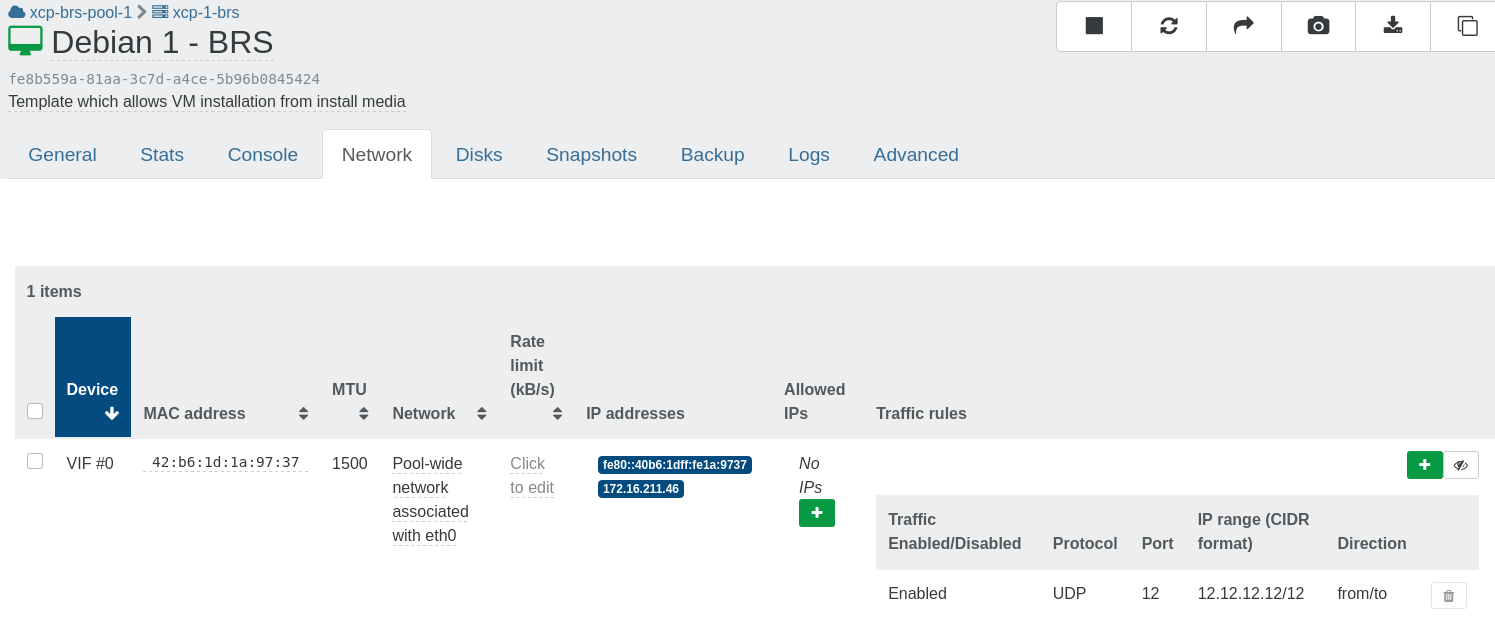SDN Controller
Be sure to enable the plugin on only one XOA instance.
The SDN Controller enables a user to create pool-wide and cross-pool private networks and more. It's available as a Xen Orchestra plugin (included in XOA Premium).
Global Private Networks
Interconnect your VMs and hosts within a dedicated and secured private network, even across different pools all around the world. This is a great way to protect "private links" (eg between applications and databases, management networks etc.) without any complicated deployment.

How does it work?
Please read the dedicated devblog on the SDN Controller and its extension for cross-pool private networks.
As VxLAN and GRE are protocols using extra encapsulation, they require extra bits on a network packet. If you create a Global Private Network with a default MTU at 1500, you won't be able to use it "as is" in your VMs, unless you configure a smaller MTU for each virtual interface, in your VM operating system (eg: 1400).
If you want something entirely transparent for your VMs, then you'll need to create a network with a MTU of 1546 for GRE or 1550 for VxLAN. However, larger MTU will require capable network equipments.
Network creation
In the network creation view:
- Select a
pool - Select
Private network - Select an interface on which to create the network's tunnels
- Select the encapsulation: a choice is offered between
GREandVxLAN, ifVxLANis chosen, then port 4789 must be open for UDP traffic on all the network's hosts (see the requirements) - Choose if the network should be encrypted or not (see the requirements to use encryption)
- Select other
pools to add them to the network if desired- For each added
pool: select an interface on which to create the tunnels
- For each added
- Create the network
- Have fun! ☺

- All hosts in a private network must be able to reach the other hosts' management interface and all hosts must be able to reach one another on the interface selected for private networks creation.
The term ‘management interface’ is used to indicate the IP-enabled NIC that carries the management traffic.
- Only 1 encrypted GRE network and 1 encrypted VxLAN network per pool can exist at a time due to Open vSwitch limitation.
Configuration
Like all other xo-server plugins, it can be configured directly via the web interface, see the plugin documentation.
The plugin's configuration contains:
cert-dir: The path where the plugin will look for the certificates to create SSL connections with the hosts. If none is provided, the plugin will create its own self-signed certificates.override-certs: Enable to uninstall the existing SDN controller CA certificate in order to replace it with the plugin's one.
Requirements
VxLAN
Encryption
- To be able to encrypt the networks,
openvswitch-ipsecpackage must be installed on all the hosts:yum install openvswitch-ipsec --enablerepo=xcp-ng-testingsystemctl enable ipsecsystemctl enable openvswitch-ipsecsystemctl start ipsecsystemctl start openvswitch-ipsec
OpenFlow rules
There are currently two implementations:
- One where the SDN Controller plugin talks directly to Open vSwitch through the OpenFlow protocol
- A newer one using a XAPI plugin on XCP-ng side that directly configures Open vSwitch
At this time, the two options are covered until we can fully deprecate the older, direct OpenFlow implementation.
OpenFlow Protocol
This feature requires opening the OpenFlow port (TCP 6653). This is done automatically by XAPI.
Limitations:
- Only on the physical host's management network (neither bond nor VLAN)
- Only supports per-VIF rules
For now, this is the default mode in Xen Orchestra.
Please see the devblog about OpenFlow rules.
In the VM network tab a new column has been added: Network rules.
- The Add rule button display a form to add a new rule choosing to:
- enable/disable the matching traffic
- for a specific protocol (optional)
- on a specific port (optional)
- matching a specific IP or IP range (optional)
- coming from the VIF / going to the VIF / both
- The Show rules button allow to display all rules for a VIF.
- When the rules are display a button to delete a rule is available.


XAPI Plugin
Two caveats:
- At this time, there is no UI in Xen Orchestra for network-wide rules. The rules can be created through
xo-cli. - This is not enabled by default, and requires a configuration change for
xo-server. See the configuration page to know more.
- Works on any network:
- Networks bound to physical interface as well as bonds
- VLAN on top of any network
- Private networks and cross-pool private networks
- Per VIF rules
- Network-wide rules
To setup a per-VIF rule using the UI, follow the openflow instructions above, as the UI is the same and only the backend changes.
Here, we describe how to use xo-cli to configure rules. First, make sure to register xo-cli to your XOA instance as documented in it's documentation.
- Add per-VIF rules:
xo-cli sdnController.addRule vifId=<VIF_UUID> <parameters> - Delete per-VIF rules:
xo-cli sdnController.deleteRule vifId=<VIF_UUID> <parameters - Add new network-wide rules:
xo-cli sdnController.addNetworkRule networkId=<NETWORK_UUID> <parameters - Delete network-wide rules:
xo-cli sdnController.deleteNetworkRule networkId=<NETWORK_UUID> <parameters
Parameters:
- ipRange: An IP or range of IPs in CIDR notation (for example
192.168.1.0/24). An IP does not need/32. - direction:
- to: means the parameters for port and ipRange are to be used as destination.
- from: means they will be used as source.
- from/to or to/from: 2 rules will be created (one per direction).
- protocol: IP, TCP, UDP, ICMP or ARP (case-insensitive).
- port: required for TCP/UDP protocol. Use
json:22so the number is passed as an integer. - allow: true or false. If set to false the packets are dropped.
Some examples:
# Per-VIF rules:
xo-cli sdnController.addRule vifId=15f1a9ec-4348-0cca-d2b8-e536db043298 direction=from ipRange=1.1.1.3 protocol=tcp port=json:4242 allow=false
xo-cli sdnController.deleteRule vifId=15f1a9ec-4348-0cca-d2b8-e536db043298 direction=from ipRange=1.1.1.3 protocol=tcp port=json:4242
xo-cli sdnController.addRule vifId=e9a7914a-9518-82e2-7052-42cb16cc9724 direction=to ipRange=1.1.1.2 protocol=icmp allow=false
xo-cli sdnController.deleteRule vifId=e9a7914a-9518-82e2-7052-42cb16cc9724 direction=to ipRange=1.1.1.2 protocol=icmp
# Network-wide rules:
xo-cli sdnController.addNetworkRule networkId=9334aa83-6960-62e5-a463-5acc05295af4 direction=to ipRange=1.1.1.2 protocol=icmp allow=false
xo-cli sdnController.deleteNetworkRule networkId=9334aa83-6960-62e5-a463-5acc05295af4 direction=to ipRange=1.1.1.2 protocol=icmp
xo-cli sdnController.addNetworkRule networkId=9334aa83-6960-62e5-a463-5acc05295af4 direction=from ipRange=1.1.1.2 protocol=tcp allow=false port=json:4242
xo-cli sdnController.deleteNetworkRule networkId=9334aa83-6960-62e5-a463-5acc05295af4 direction=from ipRange=1.1.1.2 protocol=tcp port=json:4242